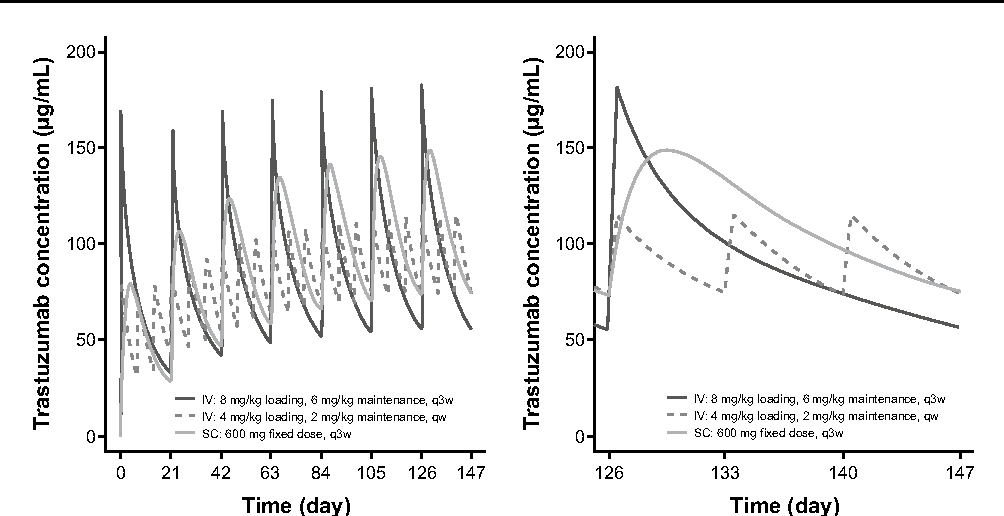
Annals of Pharmacotherapy, Volume 54, Issue 8, Page 775-779, August 2020.
Background: Subcutaneous trastuzumab (T-SC) administration does not allow the historical target concentration of 20 µg/mL for efficacy to be reached, from the start of treatment in patients with a body mass index (BMI) >30 kg/m2. Objectives: To analyze the influence of the strategy of dosification (fixed vs adjusted patient’s body weight dose) on the initial minimum plasma concentration (Cmin) of trastuzumab in obese patients. Methods: This was an observational, prospective study, which included patients with HER2-positive nonmetastatic breast cancer treated with trastuzumab. The determination of the Cmin of trastuzumab was performed on day +21 of the first cycle using the ELISA technique. Patients were stratified according to the strategy of dosification and BMI. Results: A total of 50 patients were included; 16 patients received the drug intravenously and 34 in a fixed dosage subcutaneous (T-SC) regimen. The proportion of patients who achieved an adequate plasma concentration since the beginning of treatment was significantly higher when the drug was administered intravenously (93.8% vs 67.6%, P = 0.042). These differences are especially greater in T-SC patients with BMI >30 kg/m2, with only 20% of patients exceeding the pharmacokinetic target. Conclusion and Relevance: Our study suggests that trastuzumab SC fixed dose of 600 mg is not equivalent to IV administration, especially in obese patients. An adequate trastuzumab exposure in this population needs patient weight–adjusted IV dosage in the first administration. The clinical relevance of these findings remains to be elucidated, and further research, including larger controlled trials, is warranted.
Background: Subcutaneous trastuzumab (T-SC) administration does not allow the historical target concentration of 20 µg/mL for efficacy to be reached, from the start of treatment in patients with a body mass index (BMI) >30 kg/m2. Objectives: To analyze the influence of the strategy of dosification (fixed vs adjusted patient’s body weight dose) on the initial minimum plasma concentration (Cmin) of trastuzumab in obese patients. Methods: This was an observational, prospective study, which included patients with HER2-positive nonmetastatic breast cancer treated with trastuzumab. The determination of the Cmin of trastuzumab was performed on day +21 of the first cycle using the ELISA technique. Patients were stratified according to the strategy of dosification and BMI. Results: A total of 50 patients were included; 16 patients received the drug intravenously and 34 in a fixed dosage subcutaneous (T-SC) regimen. The proportion of patients who achieved an adequate plasma concentration since the beginning of treatment was significantly higher when the drug was administered intravenously (93.8% vs 67.6%, P = 0.042). These differences are especially greater in T-SC patients with BMI >30 kg/m2, with only 20% of patients exceeding the pharmacokinetic target. Conclusion and Relevance: Our study suggests that trastuzumab SC fixed dose of 600 mg is not equivalent to IV administration, especially in obese patients. An adequate trastuzumab exposure in this population needs patient weight–adjusted IV dosage in the first administration. The clinical relevance of these findings remains to be elucidated, and further research, including larger controlled trials, is warranted.